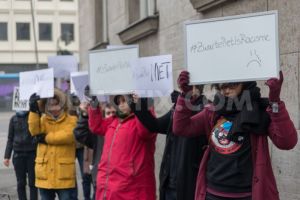 By Jamie Schearer, Board member of ENAR and of Initiative Schwarze Menschen in Deutschland
By Jamie Schearer, Board member of ENAR and of Initiative Schwarze Menschen in Deutschland
19 November 2014 – A reflection on why Zwarte Piete is racist and a legacy of the Netherlands’ history of colonialism and slavery.
As a people raised in Europe we are taught to believe in Human Rights and in democracy. We believe that these are rights that we own, rights that are guaranteed to us. We believe that it is one of our fundamental rights to not only express our opinion freely, but to do so especially when it is about our human dignity, when it is about standing up for the inalienable rights that we were supposedly given. The Dutch constitution, as well as the German one, state that people have the right to a life free of discrimination whether on the basis of race, gender or belief. However, our daily realities look very different.
During this last weekend I was reminded that these rights are only granted to certain people in society, not to those who stand against the legacy of colonialism and enslavement of Black people and highlight its continuity until today. The effects of colonialism and enslavement linger on. The controversy about Black Pete is just one form of racism as Black communities deal with higher unemployment rates, police violence, racial profiling and an educational gap.
The events in Gouda at the national parade of Sinterklaas and his ’helpers’ the Zwarte Piets this last weekend, have shown that the Netherlands is not only holding on to and perpetuating colonial imagery of Black people,
it is also silencing any protest against it. The children’s festivity, where Sinterklaas, an equivalent to Santa Claus, is accompanied by his ’helpers’ who are blackfaced, is not an innocent children’s celebration.
It is actually an initialising moment of framing Black people as ’the others’, as servants and jolly and dumb entertainers, while handing out candy, reproducing the image of colonial subjects. This form of representation of Blackness through the colonial lense makes a strong case for where we stand in 2014 as European countries. The mere presence of Black people with ’Zwarte Piet Niet’ (No to Black Pete) T-shirts even led to arrests. We, as people who were peacefully protesting, were arrested, making clear how little criticism of the current system is allowed.
Because blackfacing isn’t just a problem in the Netherlands. You find racist blackfacing across Europe, including Germany, Denmark, Sweden, Spain and so on. Often these events are not only organised through official entities, but the people financing them include Black citizens, through their tax money.
In Germany we had two cases of blackfacing on the public TV station last year. One incident took place during the Holocaust memorial day, stating that it would be censorship to change the N-word in childrens’ books. Blackfacing most of the time becomes a tool to emphasise the position of Black people in our societies. It shows us Black people that we do not have the power to define images about us. Instead they are shaped and reinforced for us by the dominant society. Hence, the protest in Gouda was about much more than a children’s celebration, it was about colonial continuity and the emancipation of Black people in 2014, about the right to self-definition and equality. It is everyone’s responsibility to ensure that we can live as equals in Europe, so think about what you can bring to the table to make it happen.